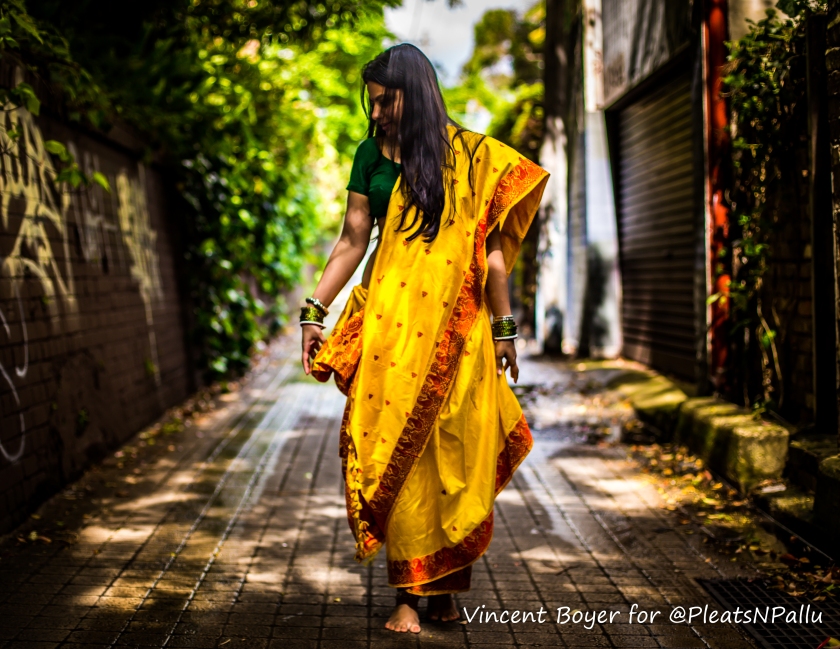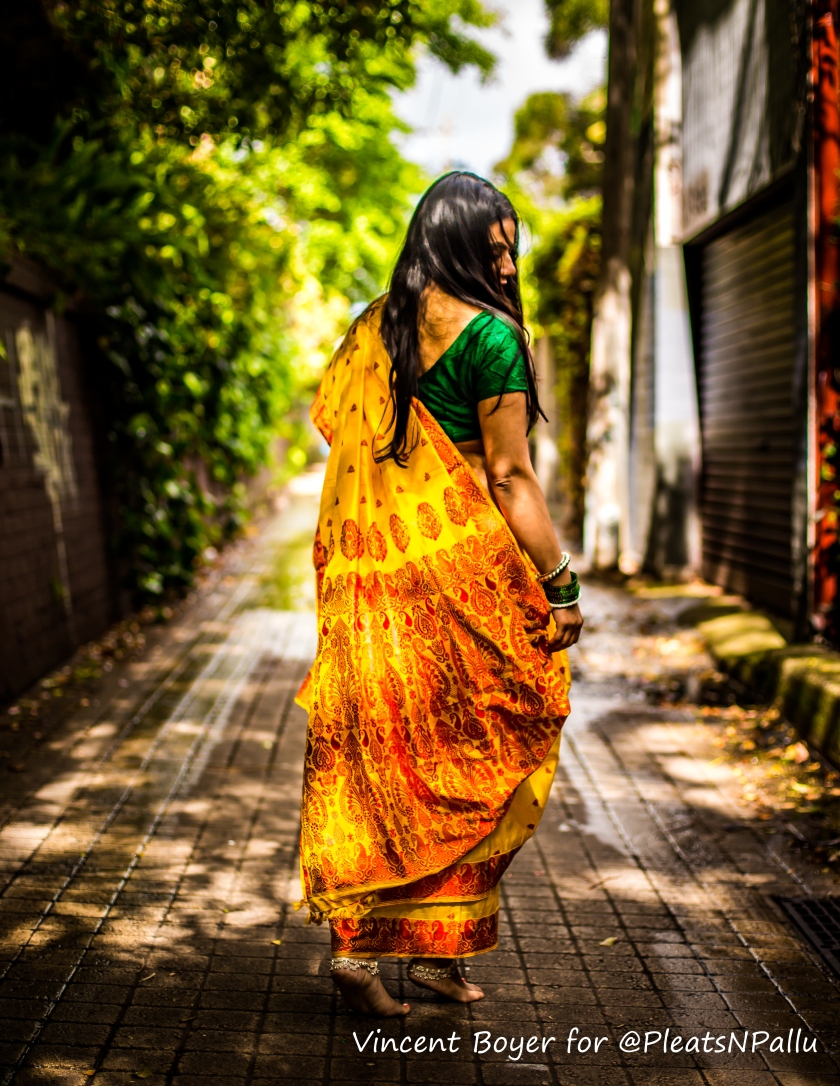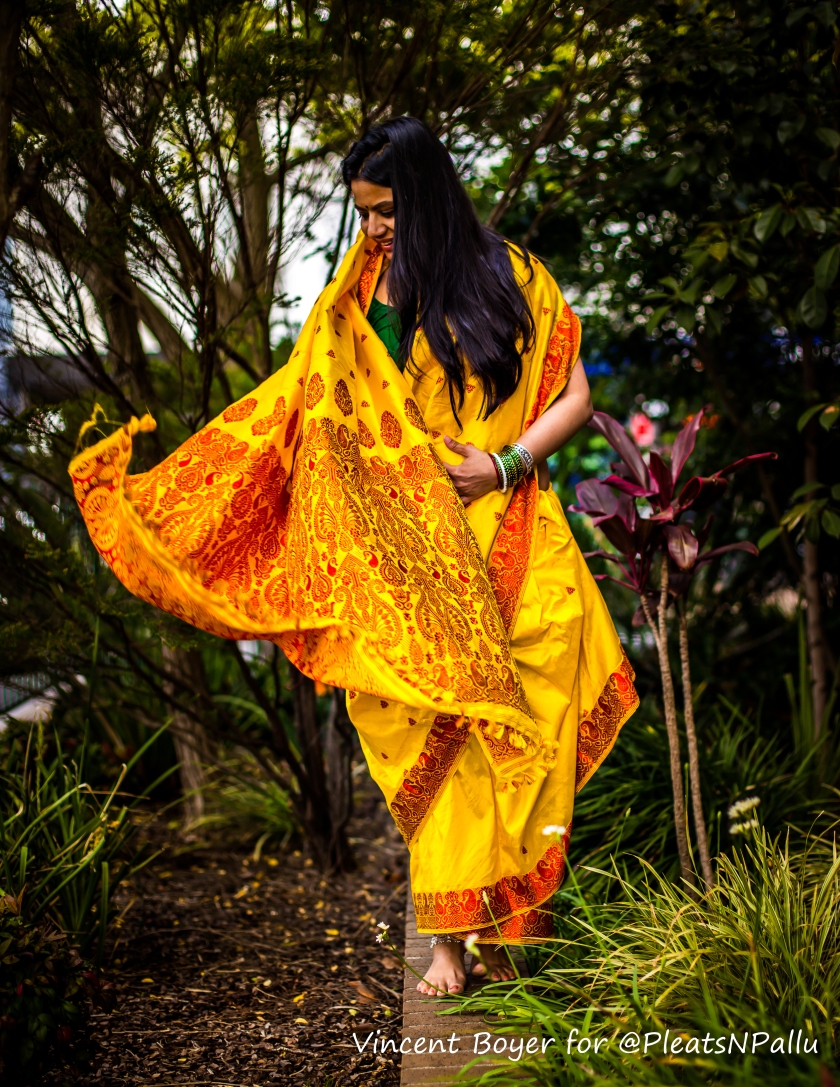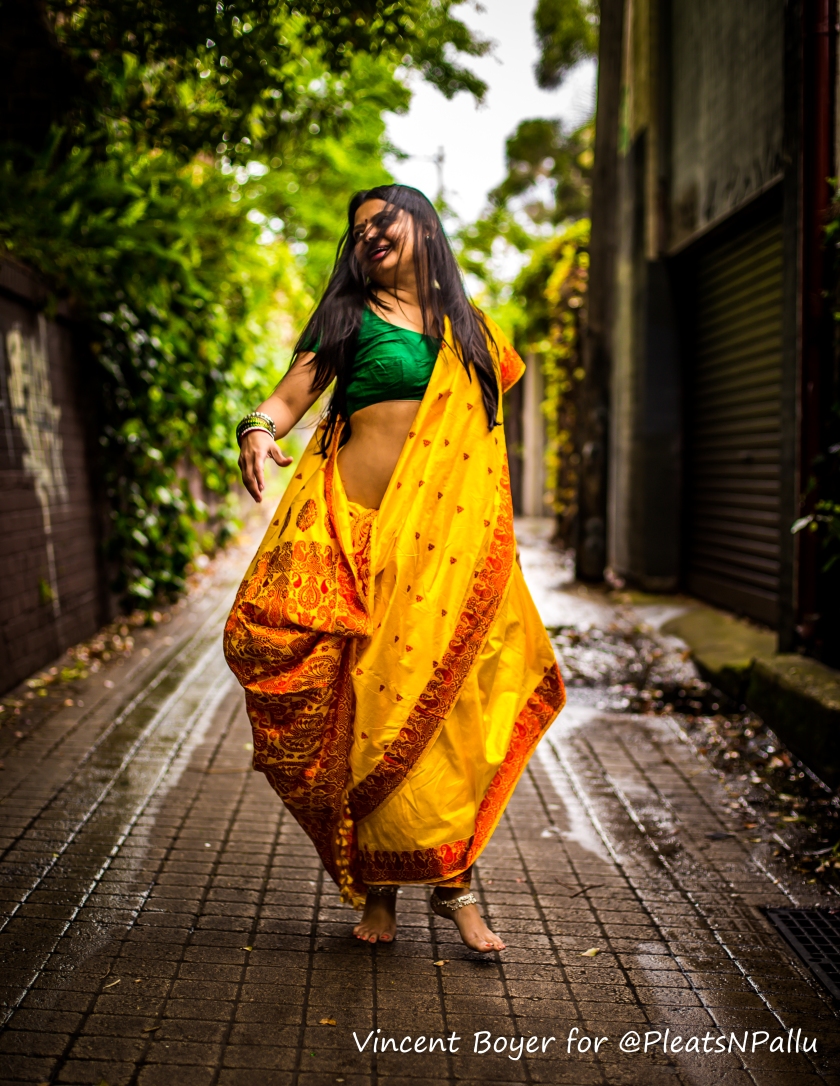Skipping around in a lush jewel toned pat/paat silk saree from Assam that radiates sunshine to go see Durga Maa and get the festive fervour started …




Photos: Vincent Boyer (Say hi on instagram @vincetravelbook)
I am a big believer in dressing up in comfortable cotton sarees for all occasions but around this season even I bring my more elaborate silks out and play dress-up. I draped this traditional handwoven fabric from the land of the red rivers and blue hills set along the banks of the mighty Brahmaputra last week along with a plain silk blouse.
Durga Pujo has just concluded a couple of days ago, but the celebration fervour is on for South Asians all over the world and we kinda don’t stop till the year end. Kali Pujo/ Diwali is just around the corner and wedding season preparations are going strong which means that resplendent sarees come out to play for most of us.
I have no desire to tell anyone else what to wear but for those who have asked me this question multiple times, here is a list of my current preferred handloom silk sarees plus a couple on my wish-list compiled to spark ideas in your mind as to what could work for you.
This list can be a good starting point for those keen to wear handcrafted silks more often and want to support textile artisans:
- Assam silks: Whether it is a pat/paat/ mulberry silk with threadwork or zari, the exquisite muga silks with its natural golden sheen or the incredible eri silk with traditional motifs I have this long running obsession with indigenous silks from the foothills of the Himalayas.
- Mulberry silk Moiring Phee: When the fluid mulberry silk meets the wonderful Manipuri motifs in extra weft weaves, I have trouble taking my eyes off the delectable concoctions. I don’t have a silk moirang phee yet but here is a previous post in a cotton one.
- Kanjivarams with minimal zari: I love kanjivarams but tend to steer away from those with a lot of zari and other embellishments because I like to let the colours and weaves do the talking. I adore the silk sarees I have too much to limit them to special occasions and love draping them during my usual escapades and textiles laden down with zari doesn’t really float my boat. You can see exactly what I mean on a previous post here.
- Gajji silk bandhani: To me bandhani is not merely a fabric; it’s a canvas of centuries of folk tales soaked in many colors and the strength of generations. Gajji silk is a veg based fabric, satin weaves with rayon warp and cotton weft, create a highly glossy surface. I love the intricate motifs, unmatched charm and splendour of the bandhani textiles from Jamnagar. Evidence of my obsession with them here, here and here.
- Tussar: Whether its tussar/ kosa handwoven in Assam or Odisha or Jharkhand or Madhya Pradesh or Maharashtra, I love this textured wild silk and cannot wait to add more of them to my regular repertoire of six yards. The temple borders of the Karvati tussars, hand block prints done on these textiles, the Ikat patterns on Gopalpur tussars as well as the kantha embroidered ones, I covet them all.
- Ikat silks: I love ikat in cottons as well as silks whether it is Sambhalpuris from Odisha, Patola from Gujarat, Pochampally from Andhra/ Telangana. The painstakingly made intricate motifs just make me skip a heart beat. You can see the evidence of my adoration here and here.
- Patur silk cottons: I didn’t know of these stunning sarees till very recently but with their deep hues they are light and easy to wear and even with a lot of zari the sarees don’t get heavy and cumbersome. These resplendent sarees in stunning colour palettes will forever have my heart, you can see one of them here.
- Banarasis with ornate borders and plain bodies: I love kattan silk sarees hand woven in the wonderous and timeless fashion that only Banaras knows! Although I am not a big fan of a lot of zari, I love the ornate borders and the enduring allure of these sumptuous heirlooms. It is the kind of luxurious masterpiece that in my opinion even the biggest couture houses can’t top. The breathtaking Banarasi opulence never ceases to amaze.
- Garad: Or as we Bengalis call it, Gawrod/ Gorod and Garad Koriyal are two varieties of traditional Bengal handloom silk. These silk sarees are distinguished by their red border and small paisley motifs. They are made from either Mulberry or Tussar and the yarn used to weave these fabrics is not dyed. The Murshidabad district of West Bengal specialises in weaving these Sarees wherein the silk yarns are woven close together which imparts the fine texture to the sarees. The koriyal is a version of Garad that has a heavier texture, giving it a more opulent look and the the Koriyal Benarasi features intricate designs on the border and pallu in gold and silver.
- Baluchari: These sarees feature beautifully hand-woven mythological figures and stories on silk, which make them unique and distinctive. Since the weaving community mainly resides in Bishnupur area of West Bengal, they are also known as Bishnupuri saris. These textiles are known for their intricate designs and handwork on them that never fail to amaze me. The motifs are dominated by stories and characters from epics like Ramayana and Mahabharata.
- Noil Silk: Noil is the fabric made from short strands and knots left over from combing wool or spinning silk, it has a slightly rough texture and drapes like a dream. It is surprisingly soft for a fabric that still has bits of cocoon woven in to it, can be gathered, pleated, or tucked at will. Previous posts in noil sarees here and here.
- Gadwal: Handwoven by the weavers at the Gadwal cluster of Mahbubnagar, Telangana the striking feature of this saree is that, while the body is made from unbleached cotton yarn, the borders and the pallu are made from tussar or mulberry silk and there is complicated interlocking of the fabrics involved. I love their unstated grandeur.
Do you have more saree suggestions? Leave a comment below and let me know.
The Assam silk saree in the photos was bought from a fabulous lady who goes exploring the deepest corners of India and Bangladesh to source locally made handlooms that are a sight for sore eyes. You can find her on instagram and facebook.